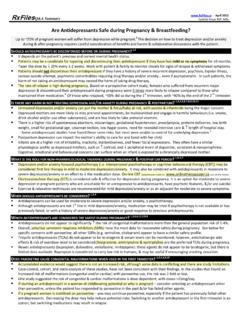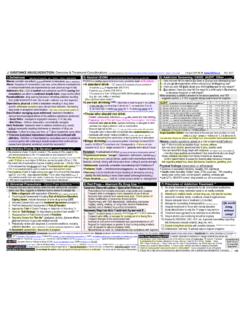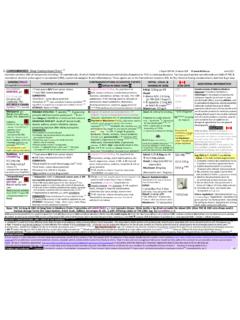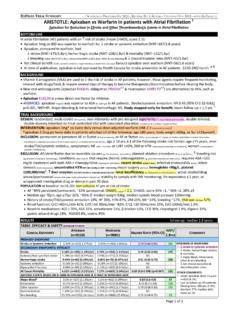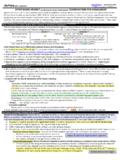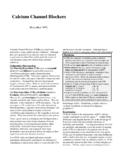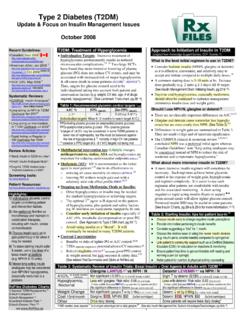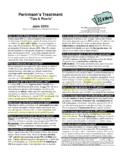Transcription of NSAIDS - DARE TO COMPARE - RxFiles
1 NSAIDsDARE TO COMPARETheRxFilesTheRxFilesTheRxFilesThe RxFilesJuly 1997 vProduced by the Community Drug Utilization Program,a Saskatoon District Health/St. Paul's Hospital programfunded by Saskatchewan Health. For more information checkour website or, contact Loren Regier C/O Pharmacy Department, Saskatoon City Hospital, 701 Queen St. Saskatoon, SK S7K 0M7, Ph (306)655-8506,Fax (306)655-8804; Email have come a long way from the days of willowbark. Today salicylates and non-steroidal anti-inflammatory drugs ( NSAIDS ) comprise one of thelargest and most commonly prescribed groups ofdrugs In Saskatchewan, over 20different agents are available, accounting for morethan 300,000 prescriptions and over $7 million insales each year (Saskatchewan Health-Drug Plandata 1996). Despite the wide selection, NSAID sare more alike than different. Although they dodiffer in chemical structure, pharmacokinetics, andto some degree pharmacodynamics, they sharesimilar mechanisms of action, efficacy, and work by inhibiting cyclooxygenase (COX)and subsequent prostaglandin synthesis as well asby other less understood mechanisms.
2 Incomparative studies between NSAIDS , no clinicallysignificant differences in efficacy have Wide variability in patients response maybe due to differences in pain threshold, diseaseseverity, cyclooxygenase configuration, and otherfactors. Since there is no method of predicting whowill respond to which NSAID, initial selection isempiric. About 60% of patients will respond to aspecific NSAID; non-responders are just as likelyto respond to an alternate agent particularly if it isfrom a different chemical of analgesia occurs rapidly with all NSAIDS ,usually within one hour. In recent years, moreexpensive, fast-acting formulations of someNSAIDs have been introduced. They are morequickly absorbed, and have a more immediate onset. While this may be advantageous in somehighly acute situations, the benefit beyond theinitial dose and in treatment of chronic pain isdoubtful.
3 In addition, anti-inflammatory activityoften requires aHighlights All NSAIDS have similar efficacy and sideeffect profiles In low risk patients, Ibuprofen and naproxenmay be first choice agents because they areeffective, well tolerated and inexpensive Acetaminophen is the recommended first lineagent for osteoarthritis Misoprostol is the only approved agent forprophylaxis of NSAID-induced ulcers and isrecommended in high risk patients if NSAIDS cannot be or more to become established. For thisreason, an adequate trial of 1-2 weeks should beallowed before increasing the dose or changing toanother NSAID. Combining NSAIDS is notrecommended as it has no additive analgesic effectand increases risk of (Toradol ) is sometimes mistaken for ananalgesic superior to the NSAIDS since it is oftencompared with the opiates. In reality, its analgesiais similar to ibuprofen and its anti-inflammatoryeffects are poor compared with other Itsonly advantage is that it is available in injectableform which can be used in situations where oralNSAIDs are excluded (eg.)
4 Acute post-op period).ADVERSE EFFECTSNSAIDs cause a variety of side effects includingnausea, diarrhea, constipation, dizziness, headache,confusion, edema, rash, and pruritis. They can alsocause more serious toxicities such as gastro-intestinal (GI) ulceration/bleeding, hematologicdisturbances, bronchospasm, angioedema, renaldysfunction, and hepatotoxicity. Many of these arerelated to NSAID inhibition of prostaglandinsynthesis other than at the desired site of salicylates are weak inhibitors ofprostaglandin synthesis and are less apt to causeadverse allergic, gastric, renal, or antiplatelet differences in toxicity between NSAID smust be interpreted in light of different utilizationpatterns and interpatient side effects are most common. Thepropionic acid derivatives such as ibuprofen andnaproxen are generally better tolerated than otherNSAIDs. Enteric coated (EC) products may reducecomplaints of stomach upset but do not appear toreduce the incidence of GI ulceration.
5 Injectableketorolac, suppository formulations, and pro-drugswhich are activated after absorption from the GI tractalso do not eliminate the problem of gastric Development of more selective COX-2inhibitors such as nabumetone and etodolac thatpreferentially inhibit cyclooxygenase at sites ofinflammation rather than in the internal organs mayhold some promise. However, long-term studies arelacking to validate claims of reduced GI GI complications may be more closely relatedto dose and duration of therapy than to any Since risk is greatest at the high end ofdosing ranges and during the first 3-6 months, dosesand duration should be minimized as much astherapeutically should be avoided in patients at high riskfor GI complications (Tables 1,2). However if theiruse cannot be avoided, addition of a prophylacticagent to reduce ulceration is is the only agent approved for theprevention of NSAID induced ulcers.
6 Misoprostolhas been shown to significantly reduce the incidenceof both gastric and duodenal ulcers in NSAID misoprostol may cause GI side effects suchas diarrhea, a gradual dosage titration may help toimprove patient tolerance and compliance. Acombination of misoprostol and ibuprofen was foundto cause a lower incidence of endoscopic ulcers thanthe selective COX-2 agent, H2blockers (eg. ranitidine), omeprazole, and sucralfateare not indicated for the prevention of NSAID induced gastric failure may result when NSAIDS are used inpatients whose kidney perfusion is dependent onlocal prostaglandin production. Sulindac wasthought to have a renal sparing effect but it appearsto be only marginally safer and cannot be prescribedwithout The COX-2 inhibitors may prove tobe less toxic but supporting data is lacking. NSAID sshould be avoided in those at high risk ofnephrotoxicity (Table 3).
7 A recent review of NSAID utilization patterns inSaskatchewan revealed that a significant number ofpatients have concomitant prescriptions for H2blockers, ACE inhibitors, diuretics, and multipleNSAIDs .12 This raises the concern that high riskpatients may be receiving inappropriate most notable difference among NSAIDS is prices vary considerably, ranging fromless than $10 a month for ibuprofen to more than$100 for high dose etodolac. The cost of treatingNSAID-related complications has additional impacton the health care system. Treatment of GI problemsalone is estimated to add over 40% to the cost ofarthritis Newer, more expensive agents do notguarantee safer, more effective treatment, and in themajority of cases do not offer significant advantagesover previously available NSAIDS . Ibuprofen andnaproxen are recommended as first line agents asthey are effective, inexpensive, and generally well-tolerated in low risk CONSIDERATIONS Consider non-pharmacologic treament ( , weight loss, hot/cold therapy) Consider using acetaminophen before NSAIDS inosteoarthritis (eg.)
8 Acetaminophen in doses of up to4 g/day is highly effective, well tolerated, and saferthan NSAIDS in osteoarthritis, and should beconsidered the drug of choice)14 Try less expensive agents first (eg. ibuprofen,naproxen) when an NSAID is indicated Use the lowest effective dose and as short aduration as possible without compromising care Allow 1-2 weeks before increasing dose orchanging agents Avoid combinations of NSAIDS Avoid NSAIDS if possible in patients at high risk ofGI or renal complicationsWe wish to acknowledge those who have assisted in the development andreview of this newsletter: Dr. Z. Tymchak (FM), Dr. P. Peloso (Rheum.),Dr. J. Richardson (Pharm.), and the CDUP Advisory Loren D. Regier BSP,BA; Sharon L. Downey BSPThe Rx Files: NSAIDS - Dare to CompareSupplementary ChartsTable 1 Risk Groupsfor NSAID Induced Ulcers*15 Age: >65 years Previous GI History: Recent Peptic Ulcer Disease Previous GI Bleed Coexisting Significant Disease Cardiovascular Hepatic or Renal Impairment Concomitant Therapy with: Corticosteroids (eg.
9 Prednisone) Anticoagulants (eg. warfarin) ASA (including low doses) * Any two risk factors constitutes a high risk individual(risk of serious bleeding >1% per year)Table 2 Prevention of NSAID Induced Ulcersin High Risk Individuals15 Avoid NSAIDS if Possible & Use Alternatives: Acetaminophen (Max 4g/day) Physiotherapy Intra-articular Corticosteroid InjectionsIf NSAIDS must be used: Use Lowest Effective Dose Limit Duration of Use where possible Add Misoprostol (Cytotec ) for Cytoprotection 100 g po daily cc x3 days then 100 g po BID cc x3 days then 200 g po BID cc thereafter (gradual dose titration recommended to promote tolerance of side effects) Reassess need for NSAID regularly Monitor for GI complications (especially over first 3 months)Table 3 Risk Groupsfor Nephrotoxicity Age: >65 Previous Renal InsufficiencyHypertension Hepatic Cirrhosis CHF Atherosclerotic Disease Concurrent Diuretic or ACE Inhibitor Use Table 4 Misoprostol / NSAID Regimens:Cost ComparisonsMisoprostol 200 g po BIDM isoprostol 200 g po BID+ Ibuprofen 400mg po TID-QIDM isoprostol 200 g po BID+ Naproxen 250-375mg po BIDM isoprostol 200 g po BID+ Diclofenac 50mg po BID-TIDA rthrotec 1 tablet po BID-TID (tablet=diclofenac 50mg / misoprostol 200 g)Arthrotec 75 1 tablet po BID (tablet=diclofenac 75mg / misoprostol 200 g)$40$52-$54$57-$65$61-$73$48-$68$61 Based on cost to patient for a 30 day Chart: NSAIDS & Other Analgesics Prepared by.
10 Loren Regier, Sharon Downey - The RxFiles , AUG/2000 Class / AgentComments /ProductsUsual DosageRangeMax/dayCost x30 days #(comparative dose)Salicylates ASA-Plain ASPIRIN ASA-Enteric CoatedENTROPHEN OTC; 650mg supp; 80,325mgtab; 81,325,650,975mg EC tab;irreversible platelet inhibition325-650mg q4-6h325-975mg QID4g650mg po QID$11 Diflunisal DOLOBID 250,500mg tab250-500mg po BID$37 Non-acetylated Salicylates - less adverse GI reactions, less cross-allergy in NSAID (& CSI?) allergic patients; available, but not commonly used Salsalate DISALCID 500,750mg tab1000mg TID3g1500mg po BID$54 Choline Mg TrisalicylateTRILISATE 500mg BID3g1000mg po BID$36 Indole Acetic Acids Indomethacin INDOCID 25,50mg cap; 50,100mg supp25-50mg TID200mg25mg po TID$17 Sulindac CLINORIL 150,200mg tab; PD150-200mg BID400mg150mg po BID$34 Tolmetin TOLECTIN 200,600mg tab; 400mg cap200-600mg TID-QID2g400mg po TID$53 Phenylacetic Acids Diclofenac ### VOLTAREN 25,50mg EC tab; 50,100mgsupp; 75,100mg SR tab25-50mg BID-TID200mg50mg po TID$22 Diclofenac+MisoprostolARTHROTEC-50 ARTHROTEC-75 (50mg + 200 g) tab(75mg + 200 g) tab1 tab BID-TID1 tab OD-BID200mg/ 800 gOne tab po BIDOne tab po BID$47$61 Pyrolizine Carboxylic Acids Ketorolac TORADOL ##; 10mg tab.
